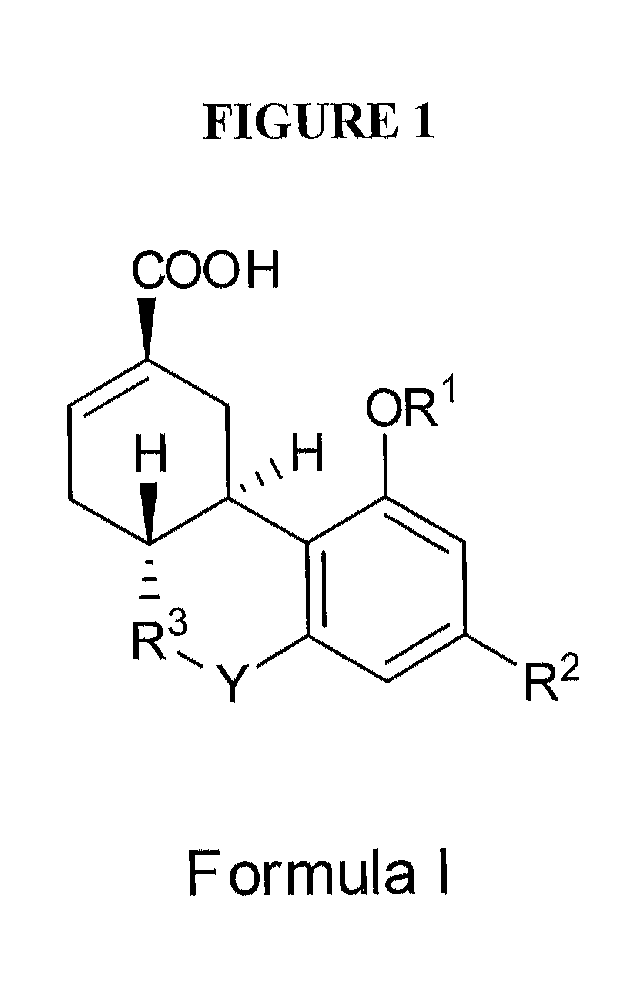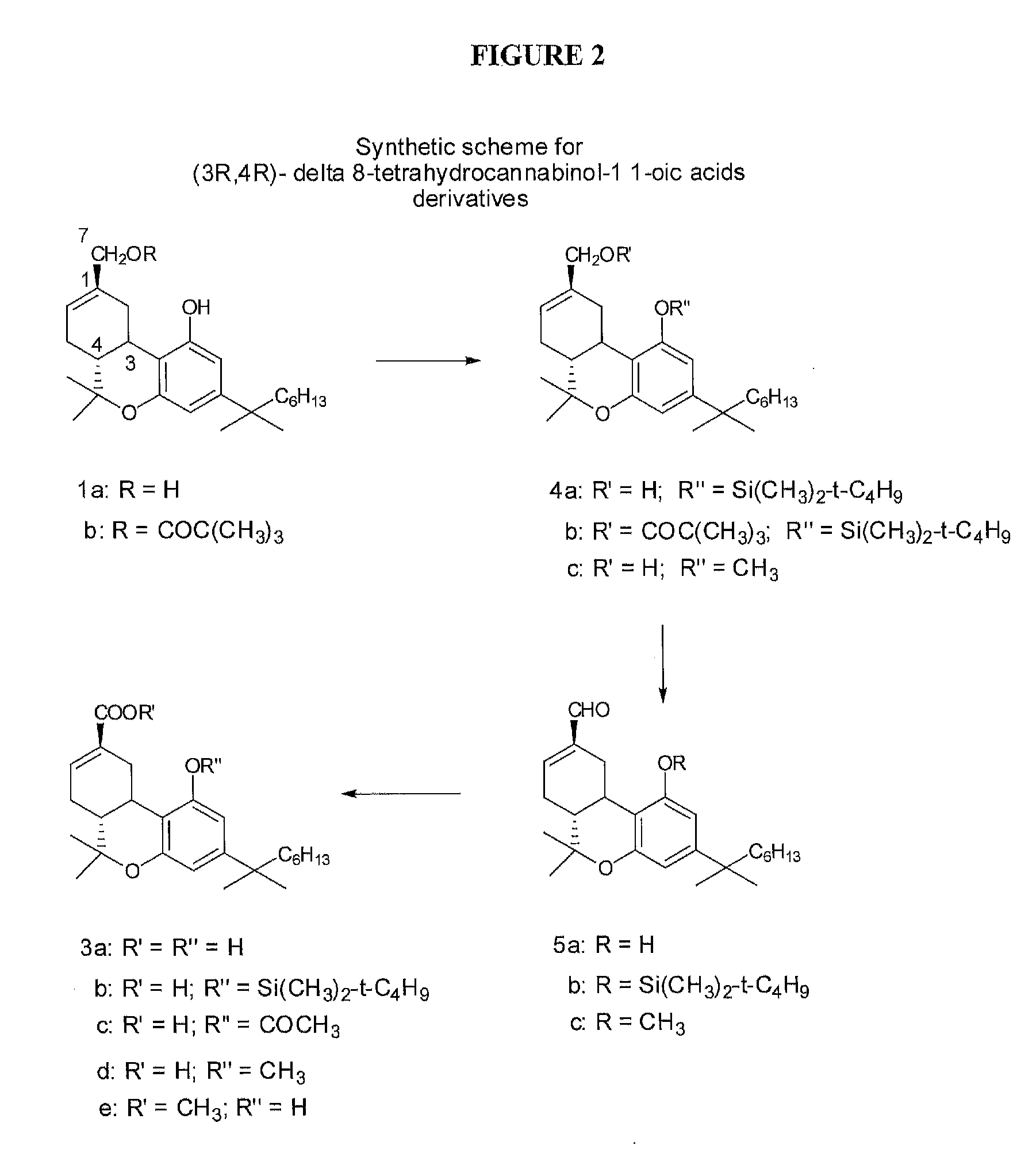[0006]In one embodiment, the invention relates to a method, comprising: a) providing: i) a subject exhibiting at least one symptom of fibrotic
disease; ii) a composition comprising ajulemic acid; b) administering said composition to said subject; and c) reducing said at least one symptom of fibrotic disease. In one embodiment, said fibrotic disease is dermal fibrosis and said symptom is dermal thickening. In one embodiment, said fibrotic disease is
lung fibrosis and said symptom is leukocyte infiltration. In one embodiment, said fibrotic disease is selected from the group consisting of scleroderma, systemic sclerosis, scleroderma-like disorders, sine scleroderma, liver cirrhosis, interstitial pulmonary fibrosis, Dupuytren's
contracture, keloids, chronic
kidney disease, chronic
graft rejection, and other scarring /
wound healing abnormalities,
post operative adhesions, and reactive fibrosis. In one embodiment, said composition is administered orally. In one embodiment, said composition is administered intravenously. In one embodiment, said composition is administered via an
implant or patch. In one embodiment, said
implant or patch provides slow release of said composition. In one embodiment, said composition is administered by
inhalation. In one embodiment, said composition is administered in a tablet.
[0007]In one embodiment, the present invention relates to a method, comprising: a) providing: i) a subject exhibiting at least one symptom of fibrotic disease; ii) a composition comprising a therapeutically effective amount of a (3R,4R)-Δ8-
tetrahydrocannabinol-11-oic acid of the formula (I); b) administering said composition to said subject; and c) reducing said at least one symptom of fibrotic disease. In one embodiment, said formula (I) is:wherein R1 is
hydrogen, COCH3 or COCH2CH3; R2 is a branched C5-C12
alkyl group which may optionally have a terminal aromatic ring, or optionally a branched OCHCH3(CH2)m
alkyl group which may have a terminal aromatic ring, wherein m is 0 to 7; and R3 is
hydrogen, a C1-8
alkyl or a C1-8 alkanol group; and Y is nil or a bridging group of NH or
oxygen; provided that where Y is
oxygen and R2 is a branched C5-C12 alkyl, R3 is not CHCH3. In one embodiment, said composition comprises a pharmaceutically acceptable salt, ester, or solvate of (3R,4R)-Δ8-
tetrahydrocannabinol-11-oic acid. In one embodiment, said fibrotic disease comprises scleroderma, systemic sclerosis, scleroderma-like disorders, sine scleroderma, liver cirrhosis, interstitial pulmonary fibrosis, Dupuytren's contracture, keloids, chronic
kidney disease, chronic graft rejection, and other scarring / wound healing abnormalities, post operative adhesions, and reactive fibrosis. In one embodiment, R1 is
hydrogen and R2 is 1′,1′-dimethylheptyl. In one embodiment, said composition has the structure:In one embodiment, R2 is a branched OCHCH3(CH2)m alkyl group terminated with a phenyl ring, wherein m is 0 to 7, and R3 is CHCH3. In one embodiment, said composition has the structure:In one embodiment, said composition is administered orally. In one embodiment, said composition is administered intravenously. In one embodiment, said composition is administered via an
implant or patch. In one embodiment, said implant or patch provides slow release of the composition. In one embodiment, said composition is administered by
inhalation. In one embodiment, said composition is administered in a tablet.
[0008]In one embodiment, the present invention relates to a method, comprising: a) providing: i) a subject exhibiting at least one symptom of fibrotic disease; ii) a composition comprising a therapeutically effective amount of a (3R,4R)-Δ8-
tetrahydrocannabinol-11-oic acid is (6aR,10aR)-4-(1,1-dimethylheptyl)-Δ8-tetrahydro-
cannabinol-9-
carboxylic acid of the formula (II); b) administering said composition to said subject; and c) reducing said at least one symptom of fibrotic disease. In one embodiment, said formula (II) is:wherein R1 is hydrogen, COCH3 or COCH2CH3; and R2 is a branched C5-C12 alkyl group which may optionally have a terminal aromatic ring, or optionally a branched OCHCH3(CH2)m alkyl group which may have a terminal aromatic ring, wherein m is 0 to 7. In one embodiment, said composition comprises a pharmaceutically acceptable salt, ester, or solvate of (3R,4R)-Δ8-tetrahydrocannabinol-11-oic acid is (6aR,10aR)-4-(1,1-dimethylheptyl)-Δ8-tetrahydro-
cannabinol-9-
carboxylic acid. In one embodiment, said fibrotic disease comprises scleroderma, systemic sclerosis, scleroderma-like disorders, sine scleroderma, liver cirrhosis, interstitial pulmonary fibrosis, Dupuytren's contracture, keloids, chronic
kidney disease, chronic graft rejection, and other scarring / wound healing abnormalities, post operative adhesions, and reactive fibrosis. In one embodiment, R1 is hydrogen and R2 is 1′,1′-dimethylheptyl. In one embodiment, R2 is a branched OCHCH3(CH2)m alkyl group terminated with a phenyl ring, wherein m is 0 to 7, and R3 is CHCH3. In one embodiment, said composition is administered orally. In one embodiment, said composition is administered intravenously. In one embodiment, said composition is administered via an implant or patch. In one embodiment, said implant or patch provides slow release of said composition. In one embodiment, said composition is administered by
inhalation. In one embodiment, said composition is administered in a tablet.
[0011]In one embodiment, the (3R,4R)-Δ8-tetrahydrocannabinol-11-oic acid is (6aR,10aR)-4-(1,1-dimethylheptyl)-Δ8-tetrahydro-
cannabinol-9-
carboxylic acid or its tautomers, its geometrical isomers, its
optically active forms as enantiomers, diastereomers and its racemate forms, pharmaceutically acceptable salts thereof, polymorphs, and combinations thereof. In one embodiment, the compound is administered orally. In one embodiment, the compound is administered intravenously. In one embodiment, the compound is administered via an implant or patch. In one embodiment, the implant or patch provides slow release of the compound. In one embodiment, the compound is administered by inhalation. In one embodiment, the compound is administered in a tablet.DEFINITIONS
 Login to View More
Login to View More  Login to View More
Login to View More 


